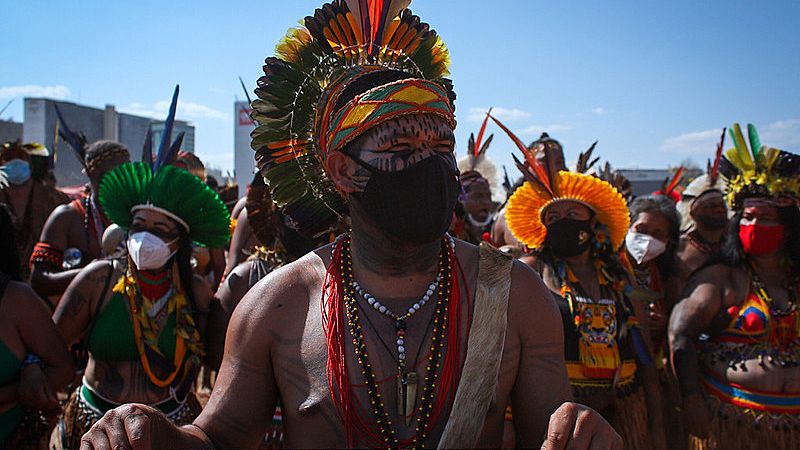Attacks on Indigenous peoples in Brazil are on the rise. During the third year of Jair Bolsonaro’s government alone, 176 Indigenous people were murdered in the country. The number is almost equal to that of 2020, when 182 Indigenous people were violently killed.
Launched on August 17, the report “Violence Against Indigenous Peoples in Brazil”, an annual publication of the Indigenous Missionary Council (CIMI), registered 355 cases of violence against Indigenous peoples throughout 2021. That is the highest rate since 2013, when the method of counting was altered.
In 2020 there were 304 cases—which, in addition to deaths, include threats, injuries, racism, sexual violence, and attempted murder. From one year to the next, therefore, there was an increase of 51 episodes of this type. “It is a degree of violence that we had not yet seen in this way,” summarizes Lucia Helena Rangel, CIMI’s anthropological advisor.
Following the same pattern since Bolsonaro assumed the presidency, the states that registered the highest number of murders of Indigenous people were Amazonas (38), Mato Grosso do Sul (35), and Roraima (32).
Responsibility of the state
“The general context of attacks on Indigenous territories, leaders and communities is related to a series of measures, on the part of the Executive Branch, that favored the exploitation and private appropriation of Indigenous lands,” evaluates CIMI’s report.
If the paralysis of the demarcation of Indigenous lands (TIs) was an unchanged guideline throughout the Bolsonaro government, over the years the consequences of this official policy represented, according to the report, “the worsening of a scenario that was already violent and appalling.”
For the sixth year in a row, CIMI registered an increase in “possessory invasions, illegal exploitation of resources, and damage to property” in TIs. In 2020, 263 invasions of the territories of Indigenous peoples were registered, while in 2021 there were 305, an increase of 16%.
“We see huge machines, armed groups, shootings and murders behind the mining of gold and some minerals like cassiterite, practiced in a violent way. These invasions have increased systematically, especially in the Amazon region. But also in other regions where there is ore,” reports Rangel.
Premeditated scenario
The situation is not only the result of state omission, but of the intentionality of the Executive and Legislative powers. Among the actions of the State that actively harm the Indigenous peoples, the report highlights Normative Instruction 09, published by Funai in 2020, which authorized the certification of private properties that are inside non-approved Indigenous lands.
In 2021, the Joint Normative Instruction of Funai and Ibama went further: it allowed the economic exploitation of Indigenous lands by organizations of “mixed composition” between Indigenous and non-Indigenous people.

“This set of actions gave the invaders confidence to advance their illegal actions on Indigenous lands. Small-scale miners developed extensive infrastructure, invaders increased the clearing of forest areas to open pastures and plant monocultures, and hunters, fishermen, and loggers intensified their incursions into the territories,” describes the document.
The struggle against the approval of this package and also of the Temporal Milestone by the Federal Supreme Court (STF) is at the center of Indigenous organizing in recent years. These struggles motivated massive national mobilizations, such as those that brought, in 2021 and 2022, about seven thousand Indigenous people to Brasília.
The (non) demarcation
According to a CIMI survey, 62% of the 1,393 Indigenous lands in the country have pending regularization. Among these, which total 871, there are 598 lands that, in spite of being claimed by Indigenous peoples, do not present any steps by the state to begin the demarcation process.
Among the conflicts over land, the report also highlights the recurrence of Indigenous lands where there is an overlapping of Rural Environmental Registries (CAR). That is, certifications of private properties on top of traditional territories. “In some cases, such as in the Uru-Eu-Wau-Wau Indigenous Lands in Rondônia and Barra Velha in Bahia,” the document illustrates, “there has been an attempt to sell ‘lots’ of land through social networks.
The mapping of the forms of violence to which the Indigenous peoples in Brazil are subjected also highlights the burning of prayer houses—primordial spaces for spirituality, resistance, and the maintenance of traditions in several Indigenous communities.
Isolated Peoples
The situation of the peoples in voluntary isolation is also getting worse. This isolation is guaranteed by federal decrees, but in some cases they have not even been renewed. The Jacareúba-Katawixi IT, in the Amazon, is one of the areas that is without protection. The decree that guarantees isolation expired in December 2021. In other cases, the ordinances were renewed, but only for a period of six months.
“The invasions have affected at least 28 ITs where there is the presence of isolated Indigenous peoples, putting the very existence of these groups at risk,” CIMI warns.
The report, available on the Council’s website, also features articles that, among other topics, address the incarceration of Indigenous people in the country; the budgetary execution of Bolsonaro’s Indigenous policy; and mechanisms for reparation and non-repetition of violations against this population.
This article was first published in Portuguese on Brasil de Fato.





